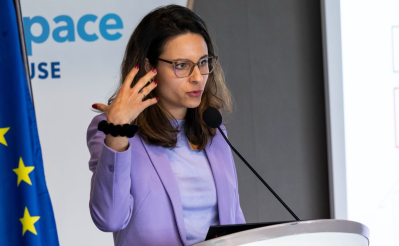News

Electric Aviation: Flying on the Pipistrel Velis Electro
Maxime Taran, Head of Operations – Flight School, ENAC
Since June 2021, ENAC has been testing the Velis Electro aircraft from Slovene manufacturer Pipistrel. In June 2020, the Velis became the first fully electric aircraft receiving a type certificate, from the European Aviation Safety Agency (EASA). After one hour of battery charge, the Velis can fly about 45 minutes. After 1h30 to 2h of charge, the autonomy increases to 1 hour or so of flight, assuming a 170km/h cruise speed and a payload of 180kg.
The two main benefits of the Velis are that this plane is silent, and it does not emit greenhouse gas as it does not burn any fuel.
Use cases of this new aircraft are multiple. Firstly, it supports the necessary transition of the ENAC flight school to greener technologies that will be undertaken through a progressive fleet renewal. Secondly, ENAC needs to assess the credibility of the Velis for the first hours of the flight training of a future airline pilot. This is what triggered the ongoing evaluation. Soon, a second Velis will be evaluated at the Carcassonne ENAC Center, starting September 2021. The airline pilot cadets will be able to perform their 10 first flight hours of their training cursus on the Velis. Training schedules and operations will have to be adjusted to account for the short range and long charging periods of the Velis, but those are the main objectives of the experimentation.
Xavier Pretat, ATC Simulator Project Manager, ENAC
It is in the context described by Maxime that I was lucky enough to get the opportunity to test the Velis. Piloting since 1991 with almost 800 flight hours on lots of different planes from Cessnas to French Jodel types, I could not miss this chance. At first glance, the Velis is a nice aircraft with the promise of a light flying behavior. The flight test confirmed this first impression.
My flight instructor of the day, Patrick, gives me the pre-flight briefing for that electric « toy ». To sum it up, everything is the same than for a “classic” (thermal) plane, except for the remaining battery energy that is always displayed in the cockpit. This information is provided as the remaining autonomy of flight (in minutes) assuming the real-time power demand. This autonomy is between 10 to 15 minutes at full throttle on takeoff, increasing to 20 minutes on initial climb, and finally reaching 45 minutes at cruising altitude.
Besides this atypical feature, the Velis is a very enjoyable plane to fly on. Aero clubs will find a nice aircraft for initial training to flight circuit. Professional flight school, like ENAC, will probably prefer to use this aircraft only for the first 5 or 10 hours of initial flight training.
Obviously, a couple of hours of extra autonomy is missing to the Velis to further extend its utilization throughout a flight training program. But we can surely see this as the first step toward a carbon-free light aviation. The Velis is more than a proof of concept. It can be used operationally right now. This is just the beginning!

Maxime Taran : IENAC 99, I started with 8 years at the en-route center of Reims in the studies subdivision, then 4 years in French Polynesia in the economic regulation, engineering and sustainable development department, then 5 years in the ATM department of ENAC, before arriving in 2019 at the Directorate of Flight and Pilot Training of ENAC.
Xavier Pretat: I have always been passionate about aviation and started flying at the age of 14. I became an air traffic control engineer in 1998, and after 10 years as an air traffic controller at the Reims en-route center, I came back to ENAC as an ATC instructor and now as an ATC simulator project manager. I was soon transferred to the DTI (Directorate of Technology and Innovation of the DSNA) as a senior expert on remote tower topics.
Pictures : Julien Orssaud
 3
3















No comment
Log in to post comment. Log in.